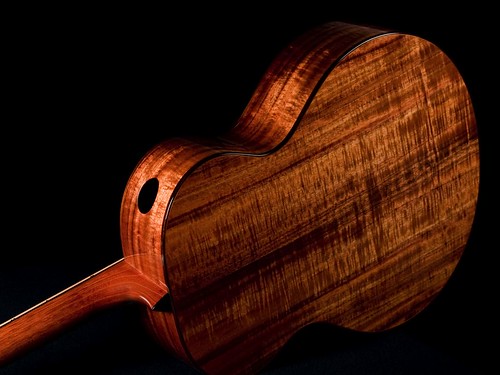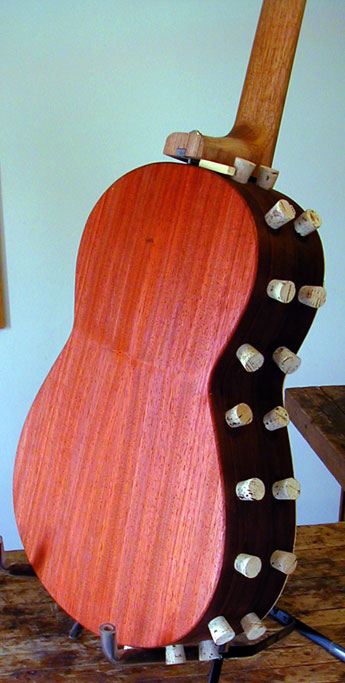
 |
|
#1
|
|||
|
|||
|
Having sound coming more directly at me is both enticing and scary. If the tones are nice, then it's wonderful. If the tones are bad, then there's no escaping it!
When the soundport is on the upper bout (example pictured), which tones generally come through; Do you hear all tones balanced? Mostly bass? Mostly Mids? Mostly trebles? Do the screechy shifting tones also come through? There is nowhere I can try out a guitar like this, so your feedback is greatly appreciated!! 
|
|
#2
|
|||
|
|||
|
As usual, the answer is more complicated than it 'ought' to be.
What you'll likely hear from a port in that location is: 1) More of the 'main air' resonant pitch, which will be displaced upward in frequency as compared to the same guitar with no port. This is usually somewhere near G#-A on the low E on a ported instrument, but could be higher. 2) There will be several peaks in the output near 'air' resonances that show high sound levels inside the box at that location. I'd expect one around 370-410 Hz (F#-G# on the high E), for example, and others a bit higher. For the most part these low frequency peaks won't be too prominent, and you may not notice them. 3) The most noticeable increase will be in a broad band around 2-4 kHz. This tends to be a large increase, with the exact pitch range probably depending on the size of the port. I strongly suspect that this is the thing that makes the most difference, since it's where your hearing is most sensitive. YMMV |
|
#3
|
|||
|
|||
|
Good OP, I was wondering about this myself.
Thanks for the informative answer Alan. |
|
#4
|
|||
|
|||
|
Maybe because I place a guitar while sitting on my left leg, I never hear too much sound from the sound ports but I love the way they look when finished nicely.

__________________
at 4. No more for awhile. Moving soon. Less is better until I settle. |
|
#5
|
|||
|
|||
|
Quote:
What you say about 2-4 khz raises a concern for me. I have some sensitive hearing in that range. I often re-eq recorded music and limit these frequencies, as well as add a low pass filter around 8 khz (depending on the music). I now have different thought in regards to ports and their usefulness that I would like to pose to you. It's in regards to the D to F# range that can be problematic on many guitars. We talked about this back in the summer of 2014 and your input was helpful. I went and found the thread; http://www.acousticguitarforum.com/f...d.php?t=347525 So what about ports to solve the problem? I was just speaking to someone else about ports in general and he said that when he ported his guitars, it took out some of the woofiness. I recall from my bass playing days that bass guitar cabinets were almost always ported. I also recall that the placement and size of the port was VERY important, as it effectively "tuned" the cabinet. Would porting a guitar help with the D to F# range?? Thank you. |
|
#6
|
||||
|
||||
|
Quote:
The one in my Kronbauer feeds my left ear, but you really cannot separate out it's sound from the rest of the guitar. It's not prominent, it's not isolated, it's not unnatural.  I have people who play that guitar for the first time just start playing and after 30 seconds or a minute I drop a cloth over the soundport. And the normal reaction is "Wow, that really makes a difference!" It sounds so natural you don't miss it till it is covered. Same that I've experienced on most guitars with side ports. The ONE exception was a road guitar sent out a couple years back - a Batson with a gaping side port (no front soundhole). The sound was overbearing, harsh, and it sounded pretty much like it would sound if you stuck your ear next to a sound hole of a normal guitar (which is why we don't aim microphones at a sound hole when we record them).   That was the only time I played a guitar with a side port which sounded bad. I've played probably close to 2 dozen McKnight guitars with side ports, and they are fabulously balanced both out front and when in the driver's seat. |
|
#7
|
|||
|
|||
|
Be prepared to have the perhaps heretofore quieter background noises associated with your technique to become more prominent.
These sounds are not always pleasant, but -- on the plus side -- may serve to help you improve your technique. |
|
#8
|
||||
|
||||
|
I don't feel the soundport is overemphasizing these higher frequencies, but is making up for the frequencies that are not normally heard by the player. From what I have read, and experienced, on a guitar without a port higher frequencies output from the guitar do not wrap around much to the player as compared to lower frequencies. So, having these high frequencies directed at the player, through the port, gives the player sound more similar to what is heard by a listener in front of the guitar.
__________________
Chuck 2012 Carruth 12-fret 000 in Pernambuco and Adi 2010 Poling Sierra in Cuban Mahogany and Lutz 2015 Posch 13-fret 00 in Indian Rosewood and Adi |
|
#9
|
|||
|
|||
|
Thanks for the replies guys. Thanks Larry, always appreciate your input. I had often wondered about those guitars with only a sideport. Too much of anything is usually a bad thing!
|
|
#10
|
|||
|
|||
|
What Chuck said: the port is pretty much making up for what you can't hear from the side, once you get up past the low range stuff.
Basically (to inject a little theory) the lowest notes on the guitar have wave lengths much longer than the box, so they radiate in all directions about equally. The player hears as much of that stuff as the audience. As you go up in pitch the instrument becomes more directional in it's output, with more of the sound going out from the top and soundhole toward the audience and less to the player. I've actually played guitars that were barely audible to the player in any sort of large or noisy room where you didn't get feedback from wall reflections. The port just adds in a monitor pointed at the player, for the most part. It can 'hear' things that the regular soundhole can't, and also has the same sort of effect that making a bigger hole would have, which is what changes the low range output. It's sort of hard to say what effect a port will have in a specific frequency range in advance. It might be possible to do some measurements of the instrument and get some idea of what would happen, but I'd hesitate to make any general predictions. The problem is that it's easy to find out by putting in the port, but hard to back out gracefully once you've done so if it isn't working the way you want. Quandaries, quandaries.... |
|
#11
|
|||
|
|||
|
Quote:
Thanks again Alan  For those interested, the succinct article can be read here -> http://www.alcarruthluthier.com/guitars/corker.htm I believe there is a more in depth one somewhere which lays out the experimental phase at length. |
|
#12
|
|||
|
|||
|
I like to describe the sound I get from my side ports as surround sound.
You don't hear one particular frequency or another (at least I don't) as much as you hear the whole package of sound get a bit louder and fuller. As Larry mentions you really hear the difference when you are playing and someone covers and uncovers the port. The sound blossoms for me when the port is uncovered. If a guitar has a tone you dislike, adding a port will not make it sound better, it stands to reason that it will make it sound worse as you will be able to hear more of that tone you don't like. All the ports I have added to my guitars have made guitars that were already great to my ears, sound ever better. 
|
|
#13
|
|||
|
|||
|
In as much as it seems generally accepted that the size of the sound hole has a significant effect on the overall tone of a guitar, would adding a side port to an existing guitar also be similar to enlarging the sound hole ?
That being the case could this have a major effect on how the player reacts to a sound port being covered over while play ? |
|
#14
|
|||
|
|||
|
Quote:
Personally, I can't stand soundports. The sound blaring in my one ear is annoying. I gave up my CA Cargo partially because the sound hole position made the perceived sound distracting to me.
__________________
Chris Larrivee's '07 L-09 (40th Commemorative); '09 00-03 S.E; '08 P-09 Eastman '07 AC 650-12 Jumbo (NAMM) Martin '11 D Mahogany (FSC) Golden Era type Voyage-Air '10 VAOM-06 -the nylon string- Goya (Levin) '58 G-30 Yamaha '72 G-170A (Japanese solid top) Garcia '67 Model 3 -dulcimer- '11 McSpadden |
|
#15
|
|||
|
|||
|
Yes; in many respects adding a port to an existing guitar is like enlarging the sound hole, but there are a couple of differences.
For one thing, it's not a one for one sort of deal: a square inch of port area will probably have a somewhat different effect on the 'main air' pitch than just enlarging the hole by a square inch. The rule of thumb there is that the further the port is from the main hole, the larger the effect. That's because as you get further from the main sound hole the pressure change in the box is greater at that frequency. The port vents that pressure, and the more it vents the more the pitch rises, and the more power it adds. For another thing, there are lots of internal 'air' resonant modes in the box, most of which don't communicate strongly with the main hole. Depending on where the port is it will pick up some sound from one or more of these. Usually those 'higher order' air modes are 'wasters' of sound; any energy they get is dissipated in friction of some sort, unless they can affect the way the wood moves. Thus they are often 'dips' in the frequency spectrum. When you vent one it can go from being a 'dip' to a 'peak', and that change in spectral content can be fairly audible, even if it doesn't amount to much extra real power. You ears are, after all, set up to detect changes. The sound may seem louder at first, just because it's different, but once you get used to it you realize that you still have to work just as hard to be heard. That 'corker' guitar was the first test mule I made for looking at ports. I've built two since. Believe me, they sound a lot better than they look! |